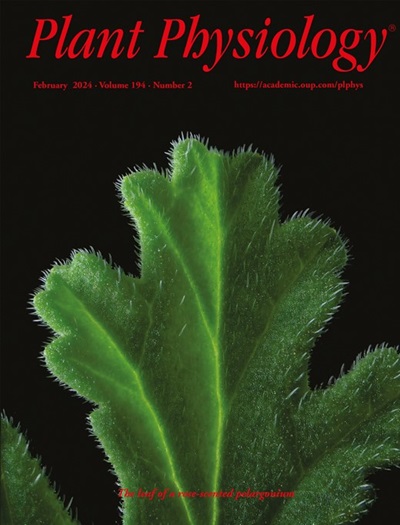转录因子PIF4和PIF5与褶皱1相互作用,调节种子成熟过程中脂肪酸的生物合成。
IF 6.5
1区 生物学
Q1 PLANT SCIENCES
引用次数: 0
摘要
PHYTOCHROME-INTERACTING FACTORS (pif)是基本螺旋-环-螺旋(bHLH)转录因子(TF)家族的成员,调控拟南芥(Arabidopsis thaliana)的多种发育过程。然而,它们在脂肪酸生物合成和种子成熟中的作用在很大程度上是未知的。wriled1 (WRI1)是调控植物脂肪酸生物合成的关键TF。在本研究中,我们确定了WRI1是PIF4和PIF5的相互作用伙伴。与WRI1类似,PIF4和PIF5在种子成熟过程中表达。过表达PIF4或PIF5触发种子脂肪酸生物合成增加,而功能缺失的PIF4和PIF5突变体表现出种子脂肪酸生物合成减少和种子成熟延迟。进一步分析发现,PIF4和PIF5促进了脂肪酸生物合成基因wr1依赖性的表达。综上所述,我们的研究结果表明PIF4和PIF5与WRI1相互作用,从而促进脂肪酸生物合成基因表达,增加脂肪酸生物合成。本研究报告了一种以前未被描述的调节机制,微调种子脂肪酸的生物合成和种子成熟。本文章由计算机程序翻译,如有差异,请以英文原文为准。
The transcription factors PIF4 and PIF5 interact with WRINKLED1 to modulate fatty acid biosynthesis during seed maturation.
PHYTOCHROME-INTERACTING FACTORS (PIFs), members of the basic helix-loop-helix (bHLH) transcription factor (TF) family, regulate various developmental processes in Arabidopsis (Arabidopsis thaliana). However, their involvement in fatty acid biosynthesis and seed maturation is largely unknown. WRINKLED1 (WRI1) is a pivotal TF regulating plant fatty acid biosynthesis. In this study, we identified WRI1 as an interacting partner of PIF4 and PIF5. PIF4 and PIF5, similar to WRI1, are expressed during seed maturation. Over-expressing PIF4 or PIF5 triggers increased seed fatty acid biosynthesis, while loss-of-function pif4 and pif5 mutants exhibit reduced seed fatty acid biosynthesis and delayed seed maturation. Further analysis revealed that PIF4 and PIF5 promote WRI1-dependent expression of fatty acid biosynthesis genes. Together, our findings suggest that PIF4 and PIF5 interact with WRI1, thereby promoting fatty acid biosynthesis gene expression and increasing fatty acid biosynthesis. This study reports a previously uncharacterized regulatory mechanism that fine-tunes seed fatty acid biosynthesis and seed maturation.
求助全文
通过发布文献求助,成功后即可免费获取论文全文。
去求助
来源期刊

Plant Physiology
生物-植物科学
CiteScore
12.20
自引率
5.40%
发文量
535
审稿时长
2.3 months
期刊介绍:
Plant Physiology® is a distinguished and highly respected journal with a rich history dating back to its establishment in 1926. It stands as a leading international publication in the field of plant biology, covering a comprehensive range of topics from the molecular and structural aspects of plant life to systems biology and ecophysiology. Recognized as the most highly cited journal in plant sciences, Plant Physiology® is a testament to its commitment to excellence and the dissemination of groundbreaking research.
As the official publication of the American Society of Plant Biologists, Plant Physiology® upholds rigorous peer-review standards, ensuring that the scientific community receives the highest quality research. The journal releases 12 issues annually, providing a steady stream of new findings and insights to its readership.
 求助内容:
求助内容: 应助结果提醒方式:
应助结果提醒方式:


